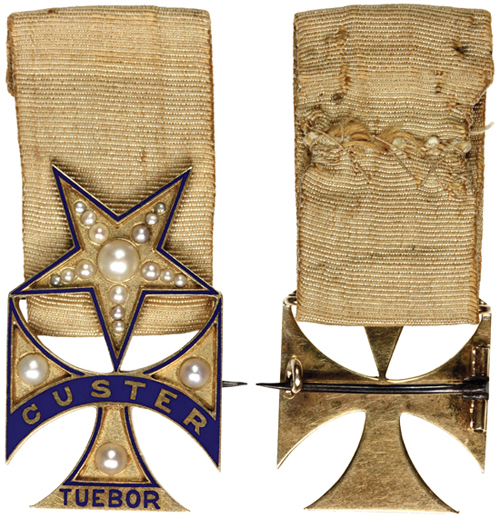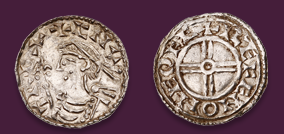
Auction: 314 - Numismatic Collector's Series Sale
Lot: 1071
ND (1864-1865) Elizabeth "Libbie" Bacon Custer Personal "Custer" Badge. 7.31gms - 14K gold, enamel, pearls and ribbon. 15mm across/32mm high/1.55mm thick. By: Tiffany & Co. of New York. Design: Maltese Cross with top vertical bar as bottom point of five-point General´s Star, the borders of both are etched and outlined with blue enamel, curved horizontal portion of the Maltese Cross with curved CUSTER, surrounding in blue enamel, TUEBOR (I will defend) at bottom of cross in blue enamel, pearl arrangement shows three mid-size freshwater pearls in inside Maltese Cross, and large central freshwater pearl at center inside General´s Star with five sets of three small descending size pearls radiating from center; back of badge shows period 1860s t-bar pin gold soldered to the badge, bar at top for ribbon suspension; period yellow-gold gross grain ribbon at top.Below is an accounting of the medal that will be reproduced with minor additions from a description provided by Civil War collector, researcher and author John Peter Beckendorf: I wrote an article entitled "Maj. Wallace´s Custer Medal" which appeared in Vol. 31 1/2005 of North South Trader Civil War. This article has been the definitive article on the topic of the Custer Badge to date. I own one of the very few known badges. The badge that I have was authorized for Captain Nelson C. Thomas of the 6th Michigan Cavalry (Thomas Badge). It allows for a comparison to be made with the Libbie Custer Badge, which the General had made as a gift for his wife. During the Civil War, the Medal of Honor was the only Congress-authorized medal of distinction for soldiers. As such, acts of bravery and valor that were not recognized by the Medal of Honor often went unrecognized. As a resolution to this, numerous privately produced medals were made - among these were the Kearny medal and cross, the Gillmore medal, and the Butler medal. The Custer medal is another among these, financed entirely by George Armstrong Custer. About mid-1864 Custer sent a design for the Custer Badge to Tiffany & Co. with instructions that these badges be crafted for individuals in the Michigan Brigade upon his specific authorization. The earliest known letter of authorization dates 15 October 1864. Numerous badges are known to have been made by Tiffany, but given that the whereabouts of Tiffany´s original production records are unknown, the exact amount, and to whom they were awarded, remains a mystery. The recorded production cost for the soldier badge was $27, quite a sum for a privately funded medal, especially given Custer´s relatively modest wealth. Given the cost, the fact that they were privately funded, and their issuance near the end of the war suggest very few were made and helps explain their rarity. A number of photographs taken between 1865 and 1866 exist of General George Armstrong Custer and his wife Libbie Bacon Custer wherein they are wearing their "Custer Badges". It may be seen in these photographs that Libbie´s badge is noticeably smaller than the General´s badge, which is a regulation badge of the pattern authorized for the officers of his Brigade. For example, the Libby Badge measures 15mm across the bottom vertical bar of the Maltese Cross, with the Cross being 20mm wide. This is quite a bit smaller than the same measurements of Thomas Badge. The Libbie Badge is also .5mm thicker than the Thomas Badge due to the incise carving and setting of freshwater seed pearls necessitating a slightly thicker platform. Libbie´s badge had been lost to history for over 140 years. It does not show up in any known photographs after 1866. Noted Custer scholar Dr. Lawrence Frost, who never saw an original Custer Badge, theorized that Libbie´s badge had been destroyed in the fire in the Custer´s home at Fort Lincoln, NE in 1873. Others theorize that it could have gone missing following an 1884 fire and robbery at her New York apartment. The whereabouts of Custer´s original badge remains unknown. However, Libbie reproduced her Custer Badge on the cover of her book "Tenting on the Plains" published in 1887. This image shows the differences in design between her badge and that of the officers of the Michigan Brigade; i.e. the curved arch of the blue enameling with the name "Custer" and a series of circles on the Maltese Cross and General´s Star. A key, previously unpublished photograph sold at auction on 10 June 2011. This image provides the clearest resolution of Libbie´s badge. On high magnification, the circles depicted on the "Tenting on the Plains" badge resolve themselves into pearls. It also appears that there is a ribbon, folded over with crossed cavalry sabers, as was standard with the Michigan Brigade badges, including the Thomas Badge. The badge, as it exists today is missing the the crossed cavalry swords that would have resided atop the ribbon. Otherwise, impreccibly preserved with no major marks and full enameling. The ribbon is bright with tight weaving. The impressive provenance of this medal (provided on page # ), especially when placed next to all in this archive, all but confirms the authenticity of the present piece. It´s reemergence after over 140 years is truly incredible. The reasons behind its lofty significance are truly numerous. Firstly, it is emblematic of the love that the General felt for her and the esteem in which she was held by the officers of the Michigan Brigade of Cavalry. It also was clearly a piece that was adored by Libbie herself as numerous photographs show her prominent display of this item and a reproduced image sits on the cover of her book. Most importantly however, the Libbie Custer badge is unique in its presentation. Given the unknown whereabouts of the General´s own medal, its existence, at least at current, speaks for both of them. All considered, it is a historic treasure fully worthy of prominent museum presentation or the finest private Civil War collection - a remarkable opportunity nearly 150 years in the making.
Sold for
$40,000




